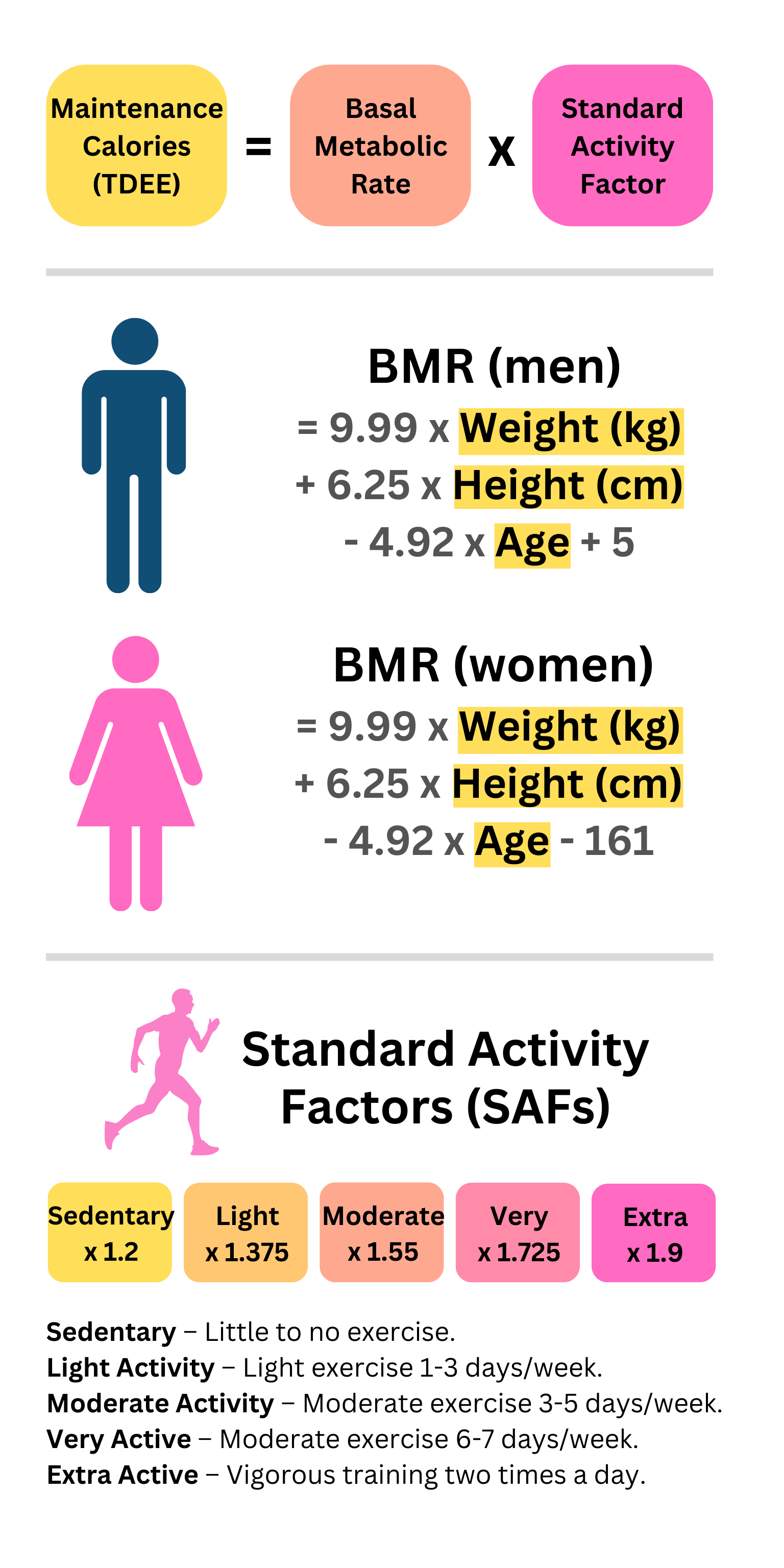| To Lose | Consume | Achieved |
|---|---|---|
0 kg per week (maintenance) | — kcal/day | — weeks |
![]()
Most Popular Calculators
Calculators to try next:
Frequently asked questions
What is the maintenance calories calculator?
Our maintenance calories calculator helps you understand how many calories you burn each day and estimates how many calories you should consume to maintain your weight over a sustained period of time.
It outputs your maintenance calories in kilocalories (kcal) or kilojoules (kJ). kcal is the standard measure of calories in most countries around the world, including the United States, while kJ is more common in Australia and New Zealand.
The calculation is based on your age, gender, height, weight and your level of physical activity. This produces a fairly accurate estimate for most people looking to maintain their current weight.
To maintain your weight over a long period of time, use the free Gym Geek app. Gym Geek uses Smart Calorie Adjustments™ to adapt to your metabolism, adjusting your maintenance calories up and down to keep your goal on track.
Explainer video: How to use the maintenance calories calculator
How does the maintenance calories calculator work?
The maintenance calorie calculator works by taking a number of inputs about you. This includes your height and your current and target weight, as well as your gender, age and activity level.
1. BMR
This first step of the calculation is estimating your Basal Metabolic Rate (BMR). This is the number of calories your body burns at rest. This does not include the calories you burn through physical activity nor the impact of digesting food after you have eaten.
2. TDEE
Once we have an estimate of your BMR, we then calculate your Total Daily Energy Expenditure (TDEE) estimate. TDEE is a measure of how many calories you burn per day, adding together your BMR along with the calories you burn through physical activity.
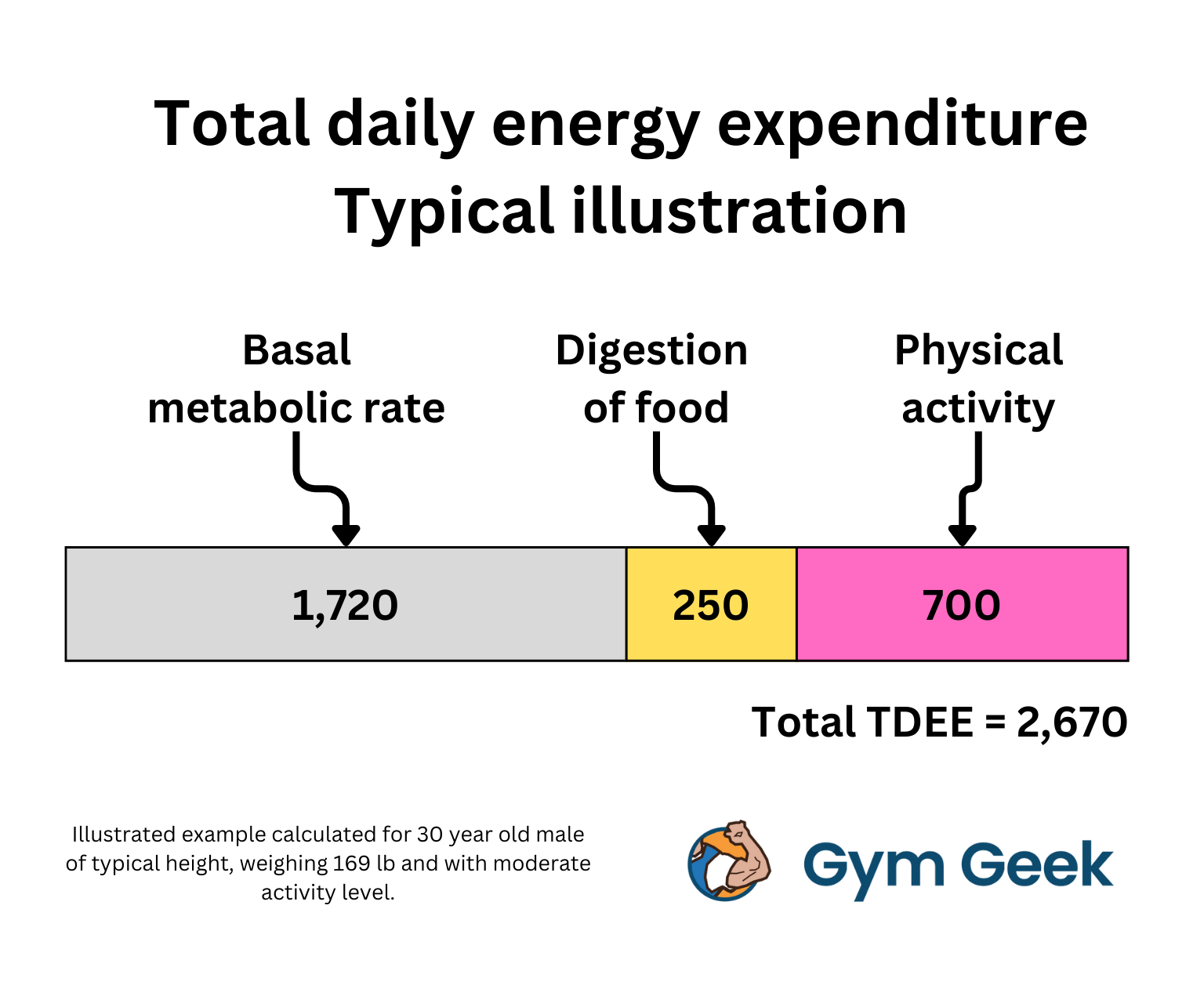
Because TDEE takes into account your activity level (i.e. whether you are sedentary, lightly active, moderately active, etc), it's a more accurate estimate of your daily calorie burn.
TDEE is sometimes called your maintenance calories, since if you eat the same number of calories you burn (expend), you will maintain weight.
In your results, the first number you see is your TDEE (or "maintenance calories"). Your TDEE is shown in kcal (kilocalories) but you can switch to kJ (kilojoules) if you prefer. If you entered a weight loss goal, you will see a range of calories, with the higher number representing your TDEE.
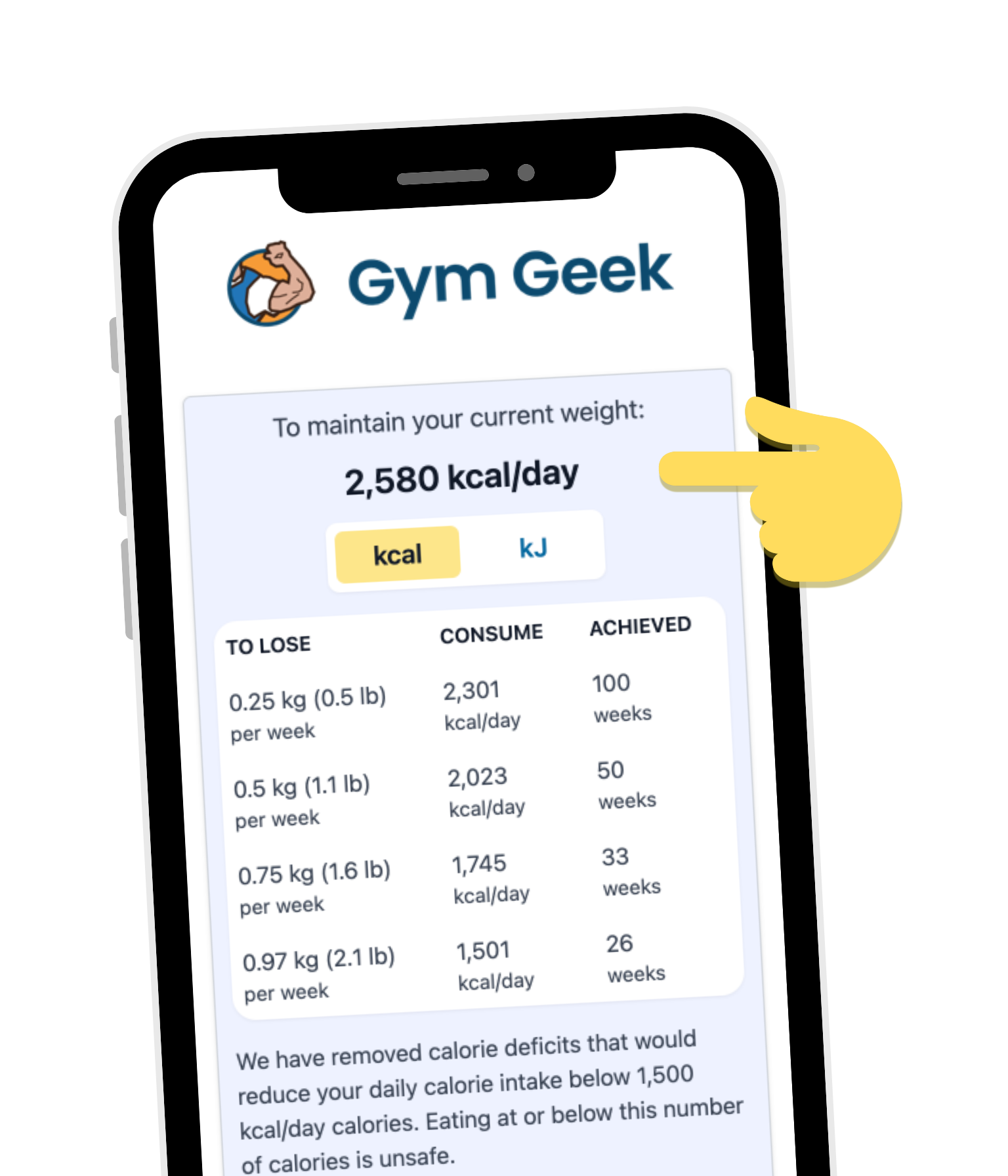
The calculator will not display any estimates below 1,200 calories for women and 1,500 calories for men. Eating at or below these number of calories is unsafe and you should always consult a doctor or suitably-qualified medical professional before engaging in extreme weight loss plans.
How is BMR calculated?
BMR, or Basal Metabolic Rate, is the number of calories your body needs at total rest to power your most basic functions. This includes the baseline activity of your organs, but does not include the digestion of food. It also doesn’t include any calories you need for physical activity and exercise.
BMR typically increases with your weight and height, because you have a larger body mass to support. However, you can expect your BMR to decrease over time as you age. This is because most people lose muscle mass and gain fat as they age.
A number of formulas for estimating BMR have been created over time. These formulas are produced by statistical studies that look at representative populations, measuring their BMR and crunching the data to build accurate formulas.
Our calculator uses the Mifflin-St Jeor equation, which came out of a 1990 study of 498 people across both genders, all age groups and normal weight and obese persons. The study introduced a formula based on a person’s weight, height, age and gender.
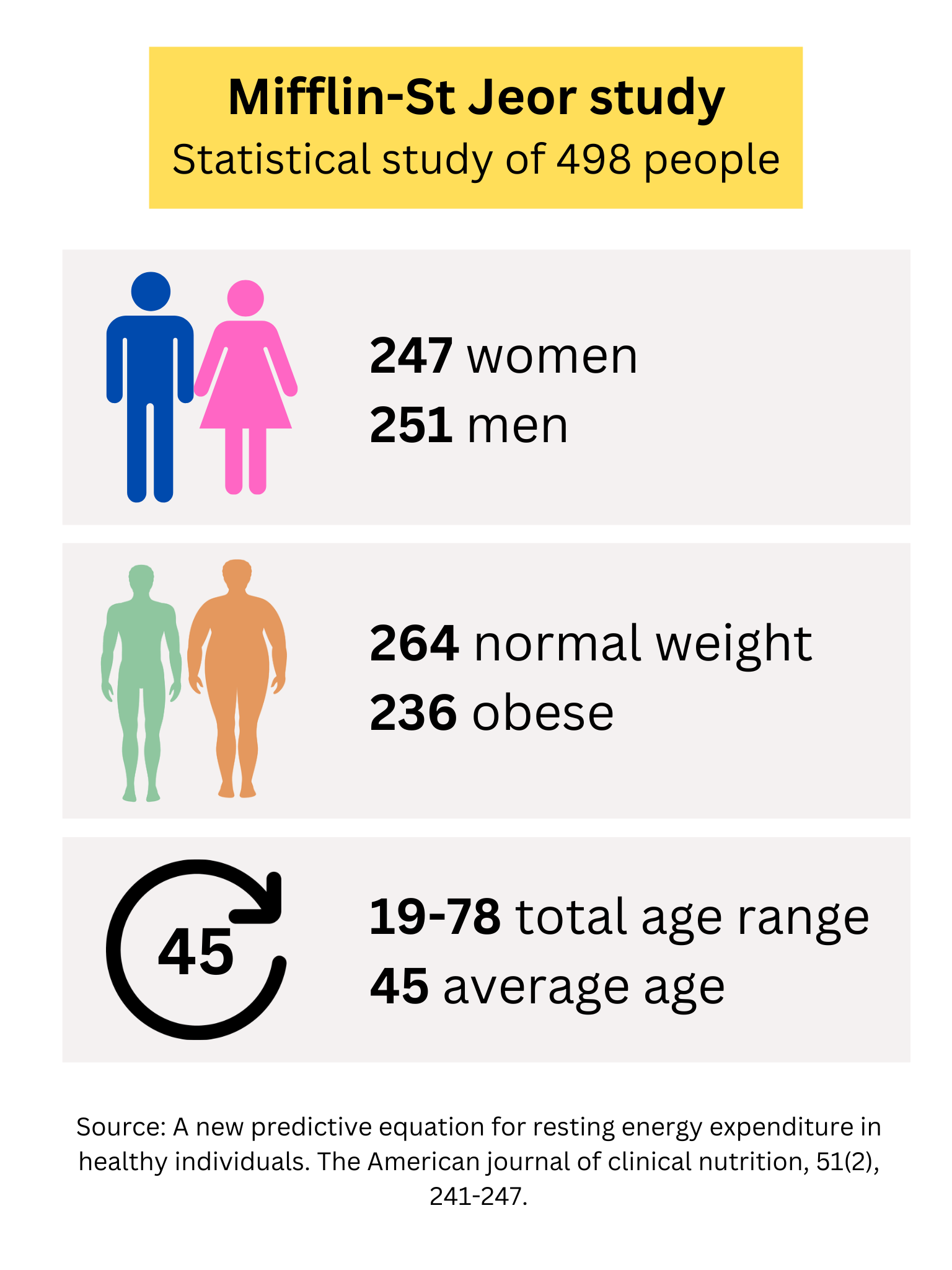
For men, the formula is 9.99 x Weight + 6.25 x Height – 4.92 x Age + 5.
For women, the formula is 9.99 x Weight + 6.25 x Height – 4.92 x Age – 161.
Is Mifflin-St Jeor accurate?
BMR calculators using Mifflin-St Jeor are fairly accurate for most people. The formula, however, does not account for specific factors like muscle mass. Specifically, if you have a high muscle mass, you may find that Mifflin-St Jeor underestimates your BMR. This is because muscle burns more calories than fat cells at rest.
If you are overweight or obese, it’s likely that Mifflin-St Jeor will overestimate your BMR.
A study published in the Journal of the American Dietetic Association concluded that the Mifflin-St Jeor equation was more likely to estimate calorie needs to within 10% compared to other equations.
How are maintenance calories (TDEE) calculated?
Our calorie calculator estimates your maintenance calories by multiplying your BMR by an activity level. The activity levels are called Harris-Benedict Standard Activity Factor (SAF) scores, and they range from 1.2 (+20%) to 1.9 (+90%), depending on your level of physical activity.
To estimate your maintenance calories, you will need to determine which SAF score fits your lifestyle best:
- Sedentary (SAF = 1.2) – Your daily life involves little to no exercise. You may work a desk-based job and spend your spare time indoors with little physical activity.
- Light Activity (SAF = 1.375) – You take part in light exercise or sports 1-3 days per week. If you work in a job where you spend time on your feet for most of the day, this may be an appropriate factor.
- Moderate Activity (SAF = 1.55) – You take part in moderate exercise or sports 3-5 days per week. This can include activities like jogging, cycling or swimming for at least 30 minutes each day.
- Very Active (SAF = 1.725) – You take part in moderate-to-vigorous exercise or sports 6-7 days per week. This can include running or playing competitive sports.
- Extra Active (SAF = 1.9) – You take part in vigorous training two times a day or have job requiring hard physical labor.
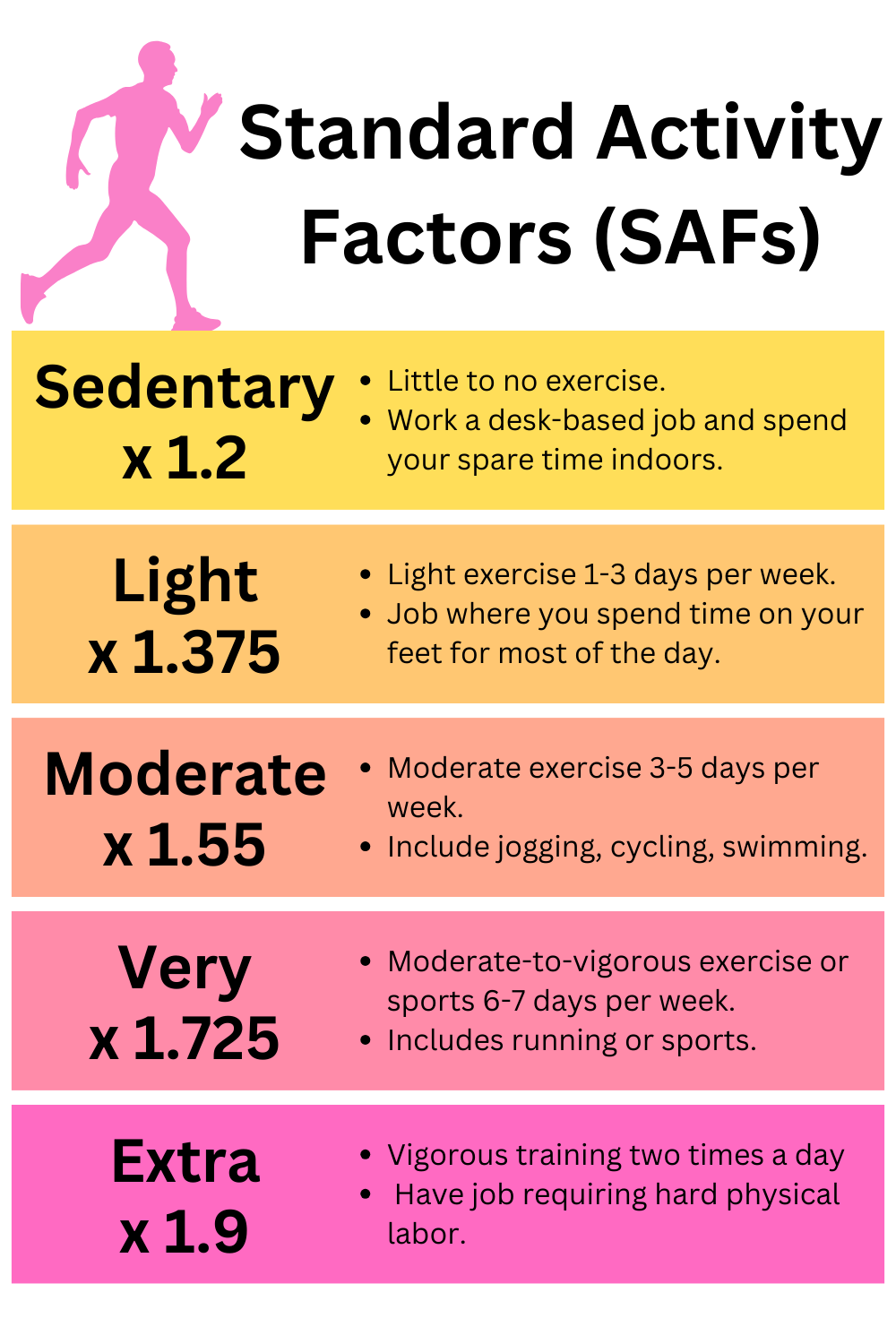
Macro breakdown
When planning your diet, your macros are essential. Your macro breakdown is the proportion of your diet made up of carbohydrates, proteins and fats. Carbs provide your body with easy-to-use energy, proteins are the essential building blocks for your muscles and other body tissue and fats help support cell growth, nutrient absorption and the production of hormones.
Our macro calculator is a simple way to get macro estimates (in grams per day) of each macro. It takes into account your current body weight, and sets a minimum protein intake based on nutritional recommendations. It then adjusts your fat and carbohydrate macros to make your overall intake as balanced as possible given your calorie deficit or excess.
Who should not use the maintenance calorie calculator?
Do not use our maintenance calorie calculator:
- If you are pregnant – Our calculator will not provide an accurate reflection of your health status as your body undergoes significant changes during pregnancy. Consult a doctor or medical professional if you are concerned about your weight.
- If you have an eating disorder – Always consult a medical professional about your weight.
- If you are under the age of 18 – BMR and TDEE estimates are not a suitable measure for children and teens under the age of 18.
References
Keys, A., Taylor, H. L., & Grande, F. (1973). Basal metabolism and age of adult man. Metabolism, 22(4), 579-587.
Fabio Comana, M. S., & PES, C. Comparing Energy Expenditure Prediction Equations.
Mifflin, M. D., St Jeor, S. T., Hill, L. A., Scott, B. J., Daugherty, S. A., & Koh, Y. O. (1990). A new predictive equation for resting energy expenditure in healthy individuals. The American journal of clinical nutrition, 51(2), 241-247.
Frankenfield, D., Roth-Yousey, L., Compher, C., & Evidence Analysis Working Group. (2005). Comparison of predictive equations for resting metabolic rate in healthy nonobese and obese adults: a systematic review. Journal of the American Dietetic association, 105(5), 775-789.



